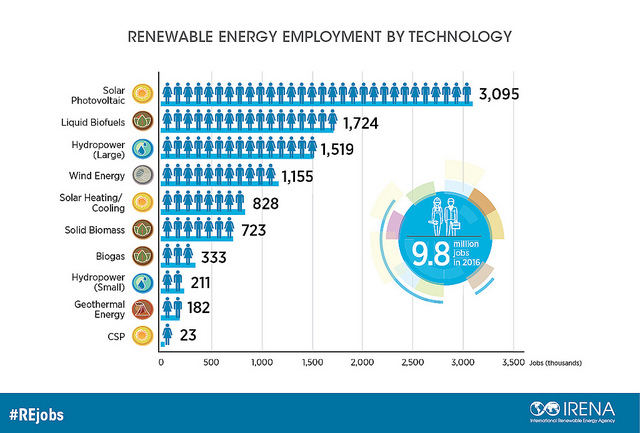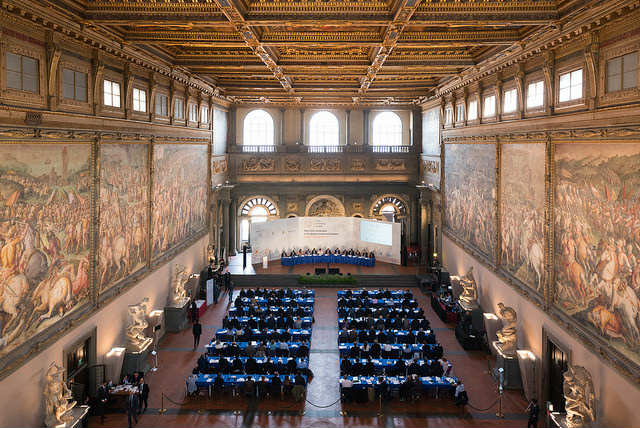

IRENA’s Year in Review 2017
Newsletter
A run-through of highlights from IRENA over the last 12 months
2017 was a remarkable year for renewables. Renewable energy costs continued to plummet, capacity expansion accelerated, and around the world, governments, companies, and ordinary people helped accelerate the global energy transition and support further renewable energy development.
With the end of the year upon us, IRENA has taken a moment to reflect on the year's activities and accomplishments. We've done this in the past, and in case you're interested here's what happened in 2016.
January

January kicked-off with IRENA’s Seventh Assembly attracting over a thousand delegates from more than 150 countries to Abu Dhabi. On the day prior to the Assembly, the Second IRENA Legislators Forum brought together lawmakers from different countries to discuss renewable energy accelerating policies. Also on the preliminary day, an event on IRENA’s SIDS Lighthouses Initiative updated IRENA Members on progress in accelerating renewable energy deployment on small islands.
The Assembly itself saw the release of a report underscoring South East Europe’s vast renewable energy potential, and hosted two Ministerial meetings on transforming the global power sector and developing off-grid renewables to fight energy poverty and support low-carbon economic growth.
An Assembly announcement revealed the renewable energy projects selected to receive funding through the IRENA/ADFD project facility, and at the following World Future Energy Summit, IRENA released a report offering guidance to energy decision makers and planners on large-scale integration of variable renewables into the power grid.
February
In February, IRENA launched a series of technology briefs, covering biofuels for aviation, and electric vehicles — describing the state of these transport technologies and their development in the future.
IRENA also released its National Energy Roadmaps for Islands publication, outlining the Agency’s roadmap methodology and highlighting specific island case studies for Barbados, Cyprus, the Dominican Republic, Kiribati, Nauru, the Maldives, and Mauritius.

March
In March, IRENA’s online project development platform, Project Navigator, released a module for developing bankable woody biomass projects. Another technology brief on biogas for transport described the technology behind a less well known sustainable road transport solution. IRENA also published its latest renewable power generation capacity figures showing that 2016 was a record year for renewable energy capacity additions with over 161 gigawatts.
At the Berlin Energy Dialogue, an IRENA and IEA decarbonisation joint study present by IRENA Director-General Adnan Z. Amin, showed that global energy-related carbon dioxide emissions can be reduced by 70% by 2050 and completely phased-out by 2060. Picked up by international press (Reuters, Bloomberg), IRENA’s look into the economic impacts of this decarbonisation found that the cumulative gain through increased GDP from now to 2050 will amount to USD 19 trillion.
The end of the month saw the release of a Renewables Readiness Assessment of the Philippines that identified the issues that the country needs to resolve to unlock its full renewable energy potential.
April
April’s release of a renewable energy roadmap for Russia, showed the country can nearly quadruple its share of renewable energy by 2030. As the world’s largest country by land area, Russia has significant potential of all renewable energy sources, with large hydropower and bioenergy being the main sources of renewables in the country’s energy system today.
A workshop in Abu Dhabi gathered representatives from governments, utilities, and regulatory authorities from Azerbaijan, Kazakhstan, Kyrgyzstan, Tajikistan, Turkmenistan, and Uzbekistan, to strengthen collaboration in accelerating Central Asia’s renewable energy development.
May
Director-General Adnan Z. Amin travelled to Beijing in May to attend the Belt and Road Forum for International Cooperation, and speak about the Belt and Road Initiative’s potential to boost the transition to renewable energy and push global energy development into a new phase.
A Renewables Readiness Assessment of Tanzania advised the country’s energy planners to explore different policy assumptions and investment scenarios, and a policy report analysed the challenges and solutions on how to adapt electricity market design to high shares of variable renewable energy.
At IRENA’s 13th Council, during which plenary sessions focused on decarbonising the energy sector with renewables, renewable energy jobs, and market design for increasing renewable energy capacity, IRENA released its annual job report. The latest job figures showed that 9.8 million are employed globally in the renewables sector, with solar photovoltaics employing 3.1 million people and China being the country with most renewable energy jobs (3.64 million).

June
Half-way through the year, IRENA was at Expo 2017 in Astana, Kazakhstan. Themed ‘Future Energy’, the Agency had a booth at the Expo and participated in a series of ministerial-level meetings. Building on the meeting held in April, a Communiqué from the five Central Asian countries highlighted the ongoing efforts across the region to create more conducive policy, regulatory, institutional and financing frameworks for renewable energy investments.
A series of meetings held in Panama City, brought national and regional stakeholders together to discuss the methodologies used in the Central American Clean Energy Corridor and to work on validating the preliminary findings of IRENA’s Renewables Readiness Assessment of Panama.

At this year's European Union Sustainable Energy Week, IRENA had a significant presence, organising two policy sessions, an IRENA booth, and by participating in a high-profile exhibition — Visualising Energy — where the Agency displayed the winners from its 2016 photo competition.
IRENA also released a working paper identifying priorities for the innovations that will enable the decarbonisation of the energy sector, and indicating that the sectors with the least progress in decarbonisation innovation are those where proper policy incentives and long-term perspectives are lacking.
July
In July, the G20 — a group of the world’s largest economies — revealed a Climate and Energy Action Plan for Growth, placing sustainable renewables at the centre of efforts to rejuvenate the global economy and address climate change.
IRENA also highlighted how solar-based solutions are enabling development and changing lives in rural Nepal. As part of its global REmap analysis, an IRENA working paper showed that asset stranding of up to tens of trillions of dollars will happen in the transition to a low-carbon economy, but that delaying action to address climate change will result in even more severe asset stranding.
August
In August, IRENA showed that the synergies between renewable energy and energy efficiency can bring faster reduction in energy intensity and lower energy costs, while the Agency participated in and organised a high-level regional meeting in El Salvador, focused on accelerating geothermal energy development in Central America.
IRENA released a renewable energy roadmap for India, showing that the country can meet a quarter of its total final energy demand with renewables by 2030, showing that biofuels — which can be used for transport, electricity generation and heating — could account for 62% of renewable’s share.


September
September saw IRENA Project Navigator release a new module on developing bankable renewable energy mini-grids projects, providing context particularly for Small Island Developing States.
IRENA established a strategic partnership with the Association of Southeast Asian Nations to accelerate the region’s transition to low-carbon, sustainable energy and build its climate resilience, and organised with Italy a Ministerial meeting to scale-up geothermal energy worldwide. Held in Florence, the high-level meeting of the Global Geothermal Alliance resulted in the adoption of the ‘Florence Declaration’, bringing countries together to identify and implement measures that will significantly increase the speed of geothermal energy development around the world.
October
In October IRENA took part in European Utility Week and the Global Science Technology and Innovation Conference, in its efforts to reach out to energy innovators and develop an innovation network.
IRENA launched a series of still ongoing lectures, highlighting the political, technological, financial, socio-economic, commercial, and regional opportunities and challenges for a future powered by renewables. Five of the lectures have now taken place and can be viewed on IRENA’s YouTube channel or website: Accelerating the Global Energy Transition; Planning for the Transformation of Power Systems; Island Energy Transitions; Approaches to Sustainable Bioenergy; and Innovation Driving the Energy Sector Transformation.
An IRENA report showed the cost of battery storage for stationary applications could fall by up to 66% by 2030.
October also saw the release of a newly revamped IRENA website, which has been organised to make finding information easier, mobile-friendly, and fit-for-purpose for today.

November
November was as busy month for IRENA with the opening of a new round of funding for renewable energy projects as part of the IRENA/ADFD Project Facility, and the start of COP23 — the UN’s annual climate conference — which was this year held in Bonn, Germany, the home of IRENA’s Innovation and Technology Centre.
To coincide with COP23, IRENA and its Coalition for Action partners launched the #Renewables4Climate campaign to raise awareness about the potential for renewable energy to reduce carbon emissions and meet the ambitions of the Paris Agreement. IRENA’s report released at COP23 on Nationally Determined Contributions (NDCs), found that current NDCs and energy strategies can be substantially enhanced to meet global climate objectives and that renewable energy already targeted within national energy strategies often exceeds renewable energy capacity currently envisaged under NDCs.

During the climate conference, IRENA organised a successful Renewable Energy Day and Small Island Developing States Day, signed an agreement with the State Grid Cooperation of China, and announced the expansion Sustainable Energy Marketplace to include Asia, Southeast Europe and Small Island Developing States.
At the end of November, IRENA held its 14th Council, which was characterised by a clear sense of collective determination to build on the momentum of the global energy transition and a redoubling of commitments to IRENA’s work as a catalyst for that process. An opinion piece produced by Director-General Adnan Z. Amin reflected on how the rise of renewables will change the geopolitical landscape for the better.
December
December saw the release of an Energy Outlook report for Thailand that by merging RRA and REmap methodologies showed the country can save over USD 9 billion by more ambitiously deploying renewables, and meet 37% of its energy demand with renewables by 2036.
IRENA’s Director-General visited Buenos Aires, to congratulate Argentina on its successful ‘Year of Renewable Energy’ and to participate in the Latin American Energy Organization’s Meeting of Ministers.
The IRENA Secretariat would like to wish you a happy New Year and festive season, and hope that you stay tuned to our channels for updates on IRENA activities and advancements in the field of renewable energy.




